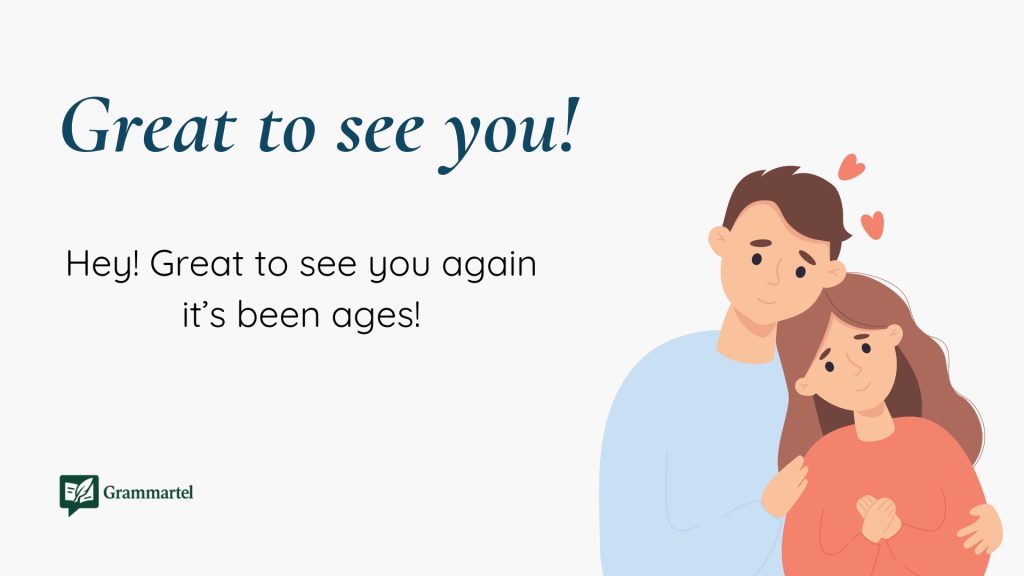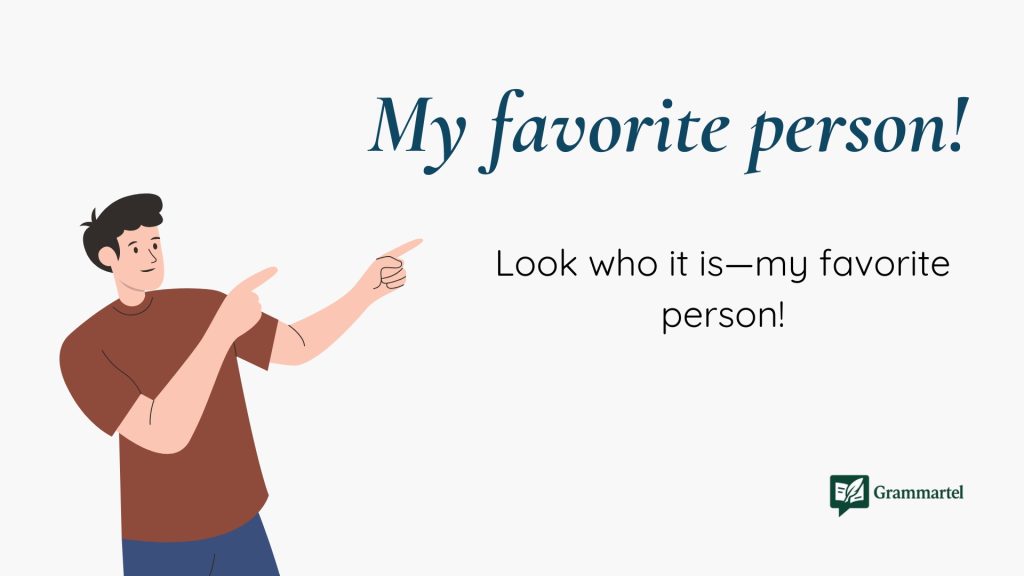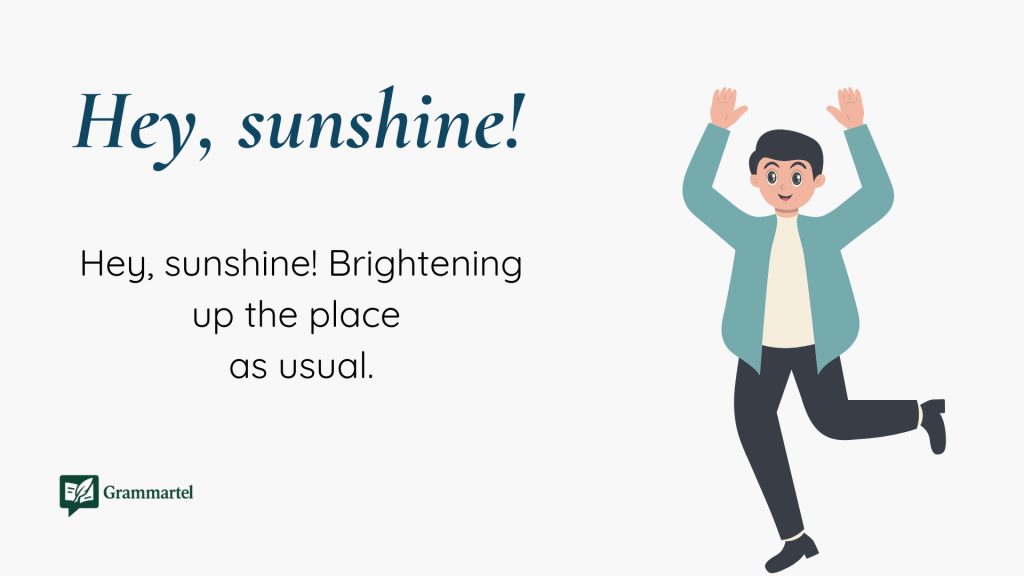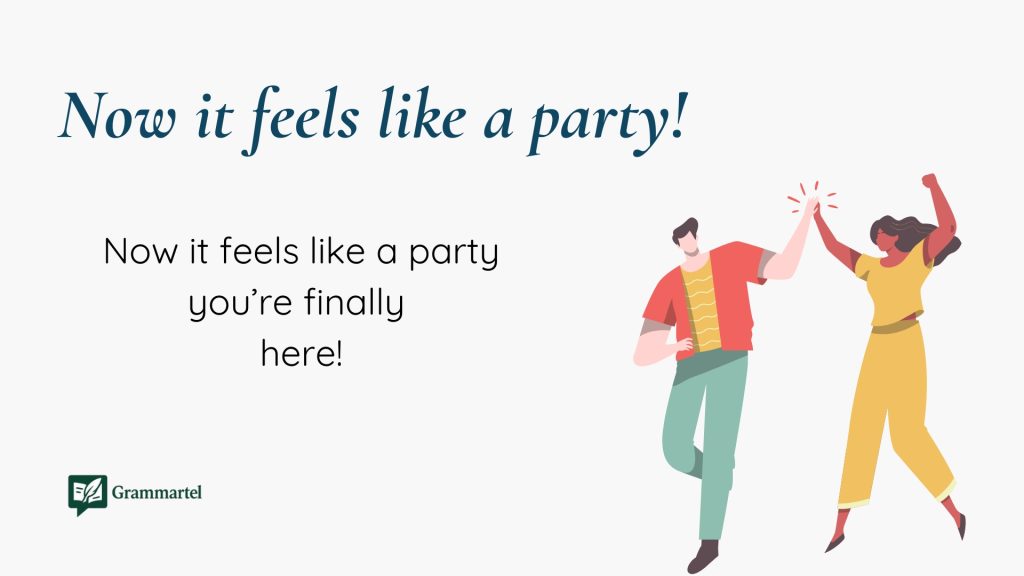Sometimes, a simple “Happy to see you” doesn’t quite hit the mark. You might want something warmer, more personal, or just a little different depending on who you’re talking to—friends, coworkers, or someone special. The good news? There are plenty of natural, easy ways to say it that still sound heartfelt. Whether you’re greeting someone after a long time or just bumping into a friend, a fresh phrase can make that moment feel more genuine and memorable.
What Does “I’m Happy for You” Mean?
The phrase “I’m happy for you” means you feel joy because something good has happened to someone else. You are not thinking of yourself. You are showing kindness and support. For example, if your friend gets a new job, you say, “I’m happy for you” to show you care and celebrate their success. It is a way to share in their good moment.
When to Use “I’m Happy for You”
Use “I’m happy for you” when someone shares good news. This can be about a promotion, marriage, new baby, or any success. Say it when you want to be kind and supportive. Use it even if you feel a little jealous, because it helps keep friendships strong. It shows you value the other person’s happiness. Always say it with a smile and mean it. This small phrase can make someone’s day better.
40 Alternatives Ways to Say “Happy to See You”
1. Great to see you!

Meaning: I’m genuinely pleased to see you.
Explanation: A classic and widely used greeting to express happiness upon seeing someone.
Example: “Hey! Great to see you again—it’s been ages!”
Best Use: When meeting friends, coworkers, or acquaintances.
Worst Use: When you’re emotionally neutral or don’t remember the person.
Tone: Friendly, warm, and casual.
2. So glad you’re here!
Meaning: I’m very happy you made it.
Explanation: Expresses gratitude or enthusiasm for someone’s presence.
Example: “So glad you’re here—we were just talking about you!”
Best Use: At gatherings or events where someone’s presence matters.
Worst Use: In overly formal or professional situations.
Tone: Warm, welcoming, and enthusiastic.
3. Long time no see!
Meaning: It’s been a while since we’ve seen each other.
Explanation: A light, casual acknowledgment of time passed.
Example: “Long time no see! How have you been?”
Best Use: Reuniting with old friends or colleagues.
Worst Use: When used sarcastically or too frequently.
Tone: Casual, friendly.
4. Look who it is!
Meaning: A playful surprise at seeing someone.
Explanation: Used to show delight and mild surprise.
Example: “Well, look who it is! You finally made it.”
Best Use: Informal settings with friends or family.
Worst Use: In formal or professional interactions.
Tone: Playful, informal.
5. There you are!
Meaning: I’ve been expecting or looking forward to seeing you.
Explanation: Can indicate relief or joy upon seeing someone.
Example: “There you are! I was starting to worry.”
Best Use: When you’ve been waiting for or missing someone.
Worst Use: When you don’t have a relationship with the person.
Tone: Warm, slightly emotional.
6. Nice seeing you!
Meaning: It’s been pleasant to see you.
Explanation: Often used when parting, but can also be used at the moment of meeting.
Example: “Nice seeing you again! Let’s catch up soon.”
Best Use: After a brief or surprise encounter.
Worst Use: If used dismissively.
Tone: Polite, neutral.
7. You look great!
Meaning: You look good and I’m happy to see you.
Explanation: Compliment and greeting rolled into one.
Example: “Wow, you look great! It’s so nice to see you.”
Best Use: With people you know well.
Worst Use: In formal business situations.
Tone: Warm, complimentary.
8. What a nice surprise!
Meaning: I’m pleasantly surprised to see you.
Explanation: Shows unexpected delight.
Example: “What a nice surprise! I didn’t know you’d be here.”
Best Use: When you weren’t expecting to meet the person.
Worst Use: If it’s obviously not a surprise.
Tone: Friendly, cheerful.
9. Been too long!
Meaning: It’s been a long time since we last met.
Explanation: A casual, friendly way of reconnecting.
Example: “Hey! Been too long—we need to catch up.”
Best Use: When reuniting after a long time.
Worst Use: In formal or first-time meetings.
Tone: Familiar, laid-back.
10. You made it!
Meaning: I’m happy you’re here.
Explanation: A joyful greeting when someone arrives.
Example: “You made it! The party can start now.”
Best Use: At events or get-togethers.
Worst Use: In professional meetings.
Tone: Excited, casual.
11. Hey, stranger!
Meaning: It’s been a while since we last talked.
Explanation: A playful, teasing way to greet someone you haven’t seen in a long time.
Example: “Hey, stranger! Where have you been hiding?”
Best Use: With friends or acquaintances you haven’t seen in a while.
Worst Use: In professional or formal situations.
Tone: Lighthearted, teasing.
12. It’s been forever!
Meaning: A long time has passed since we last saw each other.
Explanation: Emphasizes the amount of time since your last meeting.
Example: “It’s been forever! How’s everything going?”
Best Use: Reconnecting with friends or family.
Worst Use: In situations where the gap in time is minimal.
Tone: Dramatic, friendly.
13. How lovely to see you!
Meaning: I’m truly pleased to see you.
Explanation: A more refined way to express genuine happiness at someone’s presence.
Example: “How lovely to see you again, dear!”
Best Use: Semi-formal social settings, older generations.
Worst Use: In very casual or modern settings.
Tone: Polite, warm.
14. Fancy seeing you here!
Meaning: I wasn’t expecting to see you.
Explanation: Playfully acknowledges a chance meeting.
Example: “Fancy seeing you here! What are the odds?”
Best Use: Unexpected encounters in public.
Worst Use: If you did expect to see them.
Tone: Playful, light.
15. My favorite person!

Meaning: I’m very happy to see you.
Explanation: A bold way to express how much you like someone.
Example: “Look who it is—my favorite person!”
Best Use: With close friends or loved ones.
Worst Use: With people you don’t know well.
Tone: Affectionate, enthusiastic.
Read next : 40 Heartfelt Alternatives to Say “I Miss You” (With Real-Life Examples).
16. I’ve missed you!
Meaning: I haven’t seen you in a while and I’ve felt your absence.
Explanation: Shows emotional warmth and longing.
Example: “I’ve missed you! It’s so good to finally catch up.”
Best Use: Close personal relationships.
Worst Use: When there’s been no real connection or gap.
Tone: Intimate, emotional.
17. Hey, good to see your face!
Meaning: I’m happy to see you in person.
Explanation: A modern and relaxed way of greeting.
Example: “Hey, good to see your face again!”
Best Use: Informal gatherings, friendly reunions.
Worst Use: Formal events.
Tone: Casual, upbeat.
18. Always a pleasure!
Meaning: I enjoy seeing you every time.
Explanation: A warm, courteous phrase often used in partings or greetings.
Example: “Always a pleasure to see you!”
Best Use: Recurring meetings, acquaintances, colleagues.
Worst Use: With people you don’t like.
Tone: Polite, positive
19. You’re a sight for sore eyes!
Meaning: I’m really glad to see you.
Explanation: Old-fashioned idiom meaning someone’s presence is refreshing.
Example: “You’re a sight for sore eyes after that day.”
Best Use: Emotional or tiring moments.
Worst Use: When used insincerely.
Tone: Warm, emotional.
20. Welcome back!
Meaning: I’m glad you’ve returned.
Explanation: Indicates that someone was missed and is now appreciated.
Example: “Welcome back! We really missed having you around.”
Best Use: When someone returns from travel or leave.
Worst Use: When the person hasn’t really been gone.
Tone: Grateful, kind.
21. I was hoping I’d see you!
Meaning: I’m happy because I expected or wished to see you.
Explanation: Expresses anticipation and joy.
Example: “I was hoping I’d see you here today!”
Best Use: With someone you truly wanted to meet.
Worst Use: If not sincere.
Tone: Sincere, enthusiastic.
22. It’s always good to see you.
Meaning: I always enjoy your presence.
Explanation: A dependable and kind greeting.
Example: “It’s always good to see you, John.”
Best Use: For colleagues, friends, or clients.
Worst Use: If it feels forced or robotic.
Tone: Respectful, friendly.
23. Wow, what a treat!
Meaning: Seeing you is special.
Explanation: Implies delight and surprise.
Example: “Wow, what a treat! I wasn’t expecting to see you here.”
Best Use: Casual but genuine encounters.
Worst Use: Overused with everyone.
Tone: Cheerful, kind.
24. The gang’s all here!
Meaning: Everyone important is present.
Explanation: A fun group greeting.
Example: “The gang’s all here! Let’s get started.”
Best Use: Social groups, reunions.
Worst Use: One-on-one settings.
Tone: Playful, energetic.
25. Hey, sunshine!

Meaning: A cheerful, warm greeting.
Explanation: Suggests the person brings joy.
Example: “Hey, sunshine! Brightening up the place as usual.”
Best Use: Close friends, loved ones.
Worst Use: Professional or unfamiliar settings.
Tone: Affectionate, light.
26. You’ve been missed!
Meaning: Your presence has been noticeably absent.
Explanation: Implies emotional connection.
Example: “You’ve been missed around here.”
Best Use: After a long absence.
Worst Use: If the person wasn’t really missed.
Tone: Warm, genuine.
27. Good to have you back!
Meaning: I’m happy you’ve returned.
Explanation: Welcomes someone who was away.
Example: “Good to have you back with us!”
Best Use: Work, teams, social groups.
Worst Use: When they haven’t been away.
Tone: Appreciative, positive.
28. Hey, you!
Meaning: A playful and informal greeting.
Explanation: Friendly and direct, often used among peers.
Example: “Hey, you! I was just thinking about you.”
Best Use: With close friends or partners.
Worst Use: Formal situations.
Tone: Casual, cheeky.
29. It’s you!
Meaning: Recognition and delight at seeing someone.
Explanation: Shows surprise and familiarity.
Example: “It’s you! I didn’t expect to run into you today.”
Best Use: Sudden or unexpected meetings.
Worst Use: When it sounds accusatory.
Tone: Surprised, warm.
30. Glad we ran into each other!
Meaning: It’s nice that we met by chance.
Explanation: Expresses positivity in coincidence.
Example: “Glad we ran into each other—let’s grab coffee sometime.”
Best Use: Unexpected meetings.
Worst Use: Forced or impersonal conversations.
Tone: Friendly, open.
31. I was just thinking about you!
Meaning: I had you on my mind, and now you’re here.
Explanation: Expresses a sweet coincidence and appreciation.
Example: “I was just thinking about you! Funny how that happens.”
Best Use: With close friends or romantic partners.
Worst Use: With people you barely know.
Tone: Warm, sincere.
32. You’ve made my day!
Meaning: Your presence has improved my mood.
Explanation: Expresses deep appreciation or joy upon seeing someone.
Example: “You’ve made my day—so good to see you again!”
Best Use: With people who matter to you.
Worst Use: If overused or insincere.
Tone: Heartfelt, cheerful.
33. Hey, it’s been a minute!
Meaning: It’s been a little while.
Explanation: A casual and modern phrase for mild time apart.
Example: “Hey, it’s been a minute! How have you been?”
Best Use: With friends or younger crowds.
Worst Use: With elders or in formal conversations.
Tone: Informal, trendy.
34. Glad to run into you!
Meaning: Happy we crossed paths.
Explanation: A kind way to acknowledge a chance meeting.
Example: “Glad to run into you—it’s been too long.”
Best Use: Friendly encounters in public.
Worst Use: If you’re actually in a rush.
Tone: Warm, polite.
35. I was hoping you’d show up!
Meaning: I wanted you to be here.
Explanation: Conveys anticipation and pleasure.
Example: “I was hoping you’d show up—this means a lot.”
Best Use: Social gatherings, personal events.
Worst Use: When you didn’t expect or want the person.
Tone: Hopeful, kind.
Explore more : 40 Heartfelt Ways to Say “Happy Easter” (With Real Examples).
36. What brings you here?
Meaning: I’m surprised and happy to see you.
Explanation: A curious, often pleasant way to greet someone unexpectedly.
Example: “Well, hey! What brings you here today?”
Best Use: Casual, spontaneous meetings.
Worst Use: If it sounds interrogative.
Tone: Light, inquisitive.
37. You’re just in time!
Meaning: Your arrival is perfectly timed.
Explanation: Can imply that the person’s presence is welcome and helpful.
Example: “You’re just in time—we were about to get started!”
Best Use: Events, group settings.
Worst Use: When timing doesn’t actually matter.
Tone: Friendly, enthusiastic.
38. Hey, look who it is!
Meaning: I’m excited to see you.
Explanation: A lively way to acknowledge someone’s arrival.
Example: “Hey, look who it is! Come on in.”
Best Use: Social circles, family, casual workplace.
Worst Use: In very formal contexts.
Tone: Energetic, familiar.
39. You always brighten my day.
Meaning: Seeing you makes me feel better.
Explanation: A deeply appreciative and affectionate greeting.
Example: “You always brighten my day. I’m glad you’re here.”
Best Use: Close personal relationships.
Worst Use: With people you don’t know well.
Tone: Emotional, caring.
40. Now it feels like a party!

Meaning: Your presence has made things better.
Explanation: A fun way to show that someone completes the group.
Example: “Now it feels like a party—you’re finally here!”
Best Use: Social gatherings, fun events.
Worst Use: Small or serious meetings.
Tone: Playful, celebratory.
Conclusion
Language doesn’t have to be fancy to feel real. Switching up how you say “Happy to see you” can keep things fun, warm, and personal. Whether you’re reconnecting after years or catching up after a week, using different phrases helps your words feel fresh and sincere. Try a few out—you might be surprised how a small change can bring a bigger smile.
Boost your writing productivity with Grammartel intuitive features.

